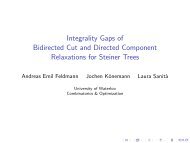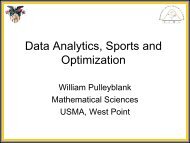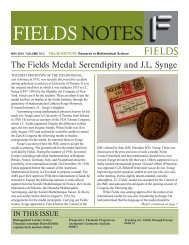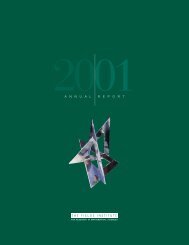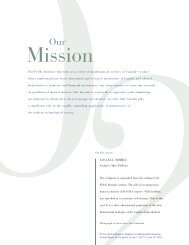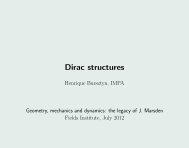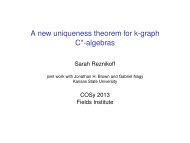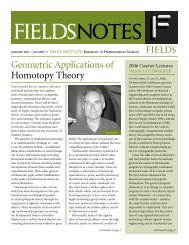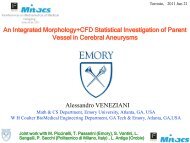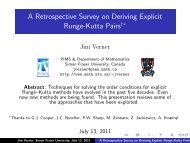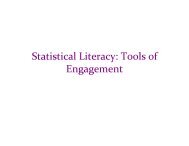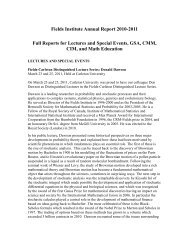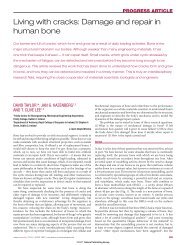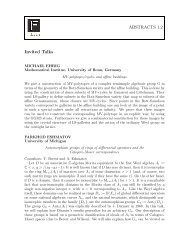Annual Report 2005 - Fields Institute - University of Toronto
Annual Report 2005 - Fields Institute - University of Toronto
Annual Report 2005 - Fields Institute - University of Toronto
Create successful ePaper yourself
Turn your PDF publications into a flip-book with our unique Google optimized e-Paper software.
GENERAL SCIENTIFIC ACTIVITIES<br />
Workshops<br />
Algebraic Topological Methods in Computer Science, II<br />
July 16–20, 2004<br />
Held at the <strong>University</strong> <strong>of</strong> Western Ontario<br />
Organizers: Gunnar Carlsson (Stanford) and Rick Jardine<br />
(UWO)<br />
The purpose <strong>of</strong> the meeting was to study and develop the<br />
applications <strong>of</strong> techniques <strong>of</strong> algebraic topology in various<br />
areas <strong>of</strong> theoretical computer science, including concurrency<br />
theory, computational geometry and problems<br />
related to combinatorics. There has been much progress in<br />
these areas since the time <strong>of</strong> the first meeting in Stanford.<br />
It is now clear that the higher dimensional automata which<br />
model parallel processing behaviour and their associated<br />
“fundamental categories” can be encoded in a purely<br />
combinatorial homotopy theory <strong>of</strong> cubical sets. Other<br />
new and interesting approaches to studying concurrent<br />
behaviour involve, respectively, a Quillen model structure<br />
on the category <strong>of</strong> 2-categories, and the homotopy theory<br />
<strong>of</strong> simplicial presheaves on a category <strong>of</strong> spaces admitting<br />
local partial orders.<br />
Several talks were presented on the detection <strong>of</strong> shapes<br />
from point cloud data. The most effective and well understood<br />
method <strong>of</strong> carrying out such an analysis involves<br />
persistent homology, which amounts to keeping track <strong>of</strong><br />
Betti numbers <strong>of</strong> simplicial complexes built from the data<br />
set as more data points are taken into account. The basic<br />
idea, which has proven to be quite robust experimentally,<br />
is that good Betti numbers (i.e. those which represent real<br />
features) should appear and persist once the resolution <strong>of</strong><br />
the data is sufficiently fine.<br />
There was an interesting discussion <strong>of</strong> a program initiated<br />
by Lovasz, concerning his cell complex Hom(G,H), which<br />
is defined for graphs G and H. The idea is that this complex<br />
contains obstructions to the existence <strong>of</strong> maps from G to H.<br />
The question <strong>of</strong> the existence <strong>of</strong> such maps in the case when<br />
H is a complete graph amounts to the graph colouring<br />
problem. Kozlov has recently proved a conjecture <strong>of</strong> Lovasz<br />
which asserts that if G is a cycle <strong>of</strong> odd length and the cell<br />
complex Hom(G,H) is k-connected, then the chromatic<br />
number <strong>of</strong> H is greater than or equal to k + 4. The method<br />
<strong>of</strong> pro<strong>of</strong> involves spectral sequence calculations and manip-<br />
G e n e r a l S c i e n t i f i c A c t i v i t i e s<br />
ulations <strong>of</strong> Stiefel-Whitney classes. The homotopy theory <strong>of</strong><br />
graphs which should underly this discussion remains to be<br />
explored.<br />
Support for the meeting was received from NSF and the<br />
<strong>Fields</strong> <strong>Institute</strong>.<br />
Speakers:<br />
Saugata Basu (Georgia Tech.)<br />
Efficient algorithms for computing the Betti numbers <strong>of</strong> semialgebraic<br />
Sets<br />
Peter Bubenik (EPF, Lausanne)<br />
Towards a model category for local po-spaces<br />
Gunnar Carlsson (Stanford)<br />
Topology <strong>of</strong> point cloud data<br />
Anne Collins (Stanford)<br />
A barcode shape descriptor for curve point cloud data<br />
Peter Csorba (ETH, Zürich)<br />
Homotopy types <strong>of</strong> box complexes<br />
Vin de Silva (Stanford)<br />
Harmonic methods in computational topology<br />
Herbert Edelsbrunner (Duke)<br />
Elevation on a 2-manifold<br />
Robin Forman (Rice)<br />
A topological approach to the game <strong>of</strong> “20 Questions”<br />
Robert Ghrist (Illinois)<br />
Reconfiguration and the geometry <strong>of</strong> cube complexes<br />
Eric Goubault (CEA Saclay)<br />
Algorithms for computing fundamental categories, and applications<br />
to the static analysis <strong>of</strong> concurrent programs<br />
Kathryn Hess (EPF, Lausanne)<br />
Quillen model categories applied to concurrency theory<br />
Rick Jardine (UWO)<br />
Higher order automata, cubical sets, and some conjectures <strong>of</strong><br />
Grothendieck<br />
<strong>Fields</strong> <strong>Institute</strong> <strong>2005</strong> ANNUAL REPORT 54



